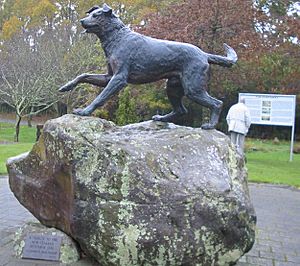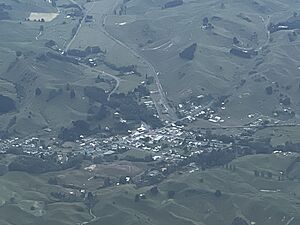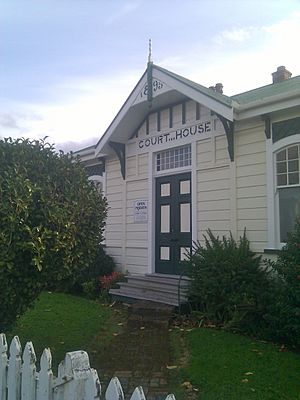Hunterville facts for kids
Quick facts for kids
Hunterville
|
|
|---|---|

Monument paying tribute to Huntaway dogs at Hunterville
|
|
| Country | New Zealand |
| Region | Manawatū-Whanganui |
| District | Rangitikei District |
| Wards |
|
| Electorates |
|
| Area | |
| • Total | 3.22 km2 (1.24 sq mi) |
| Population
(June 2023)
|
|
| • Total | 420 |
| • Density | 130.4/km2 (338/sq mi) |
Hunterville is a small town in the Rangitikei area of the North Island of New Zealand. It is located about halfway between Taupo and Wellington. You can find it right on State Highway 1, which is a main road. In 2018, about 408 people lived there.
The town got its name from George Hunter. He was a member of the Wellington Provincial Council, which was a local government group. Hunterville sits in the foothills, acting like a gateway to the Central Plateau. The main railway line also runs through the town.
The closest airport is RNZAF Base Ohakea, which is an important base for the Royal New Zealand Air Force. It is about 33 kilometers southwest of Hunterville. Just 6 kilometers north of Hunterville, you'll find a place called Vinegar Hill.
Hunterville is famous for its statue of the huntaway dog. Huntaways are special sheepdogs that use their barks to move sheep. Every year, after Labour Day, the town holds a festival and market. A big event there is the "Shepherds Shemozzle." This is a race where shepherds and their dogs compete. Shepherds come from all over New Zealand to try and win the top prize.
South of Hunterville, there are marae (traditional Māori meeting grounds) in a place called Rātā. These marae are connected to the Ngāti Hauiti hapū (sub-tribes). Tāhuhu Marae, with its meeting house Te Ruku a Te Kawau, is a gathering place for Ngāti Haukaha. Rātā Marae (also called Te Hou Hou or Potaka Marae) and its Hauiti meeting house are for Ngāti Ruaanga and Ngāti Tamateraka.
Contents
Hunterville's Past
For many years, from 1895 to 1948, a local newspaper called the Hunterville Express was printed in the town. It was one of 45 newspapers started by Joseph Ivess. Other people who worked on the newspaper included Cuthbert James Powell and Walter Keay. Walter Keay was also a writer. His wife had signed a petition in 1893, which helped women get the right to vote in New Zealand. In 1905, the newspaper was called the Hunterville Express and Upper Rangitikei Advertiser and came out three times a week. The newspaper's office burned down in 1917.
The Hunterville railway station opened in 1887. It was part of the North Island Main Trunk line, a major railway route. The station closed in 1988.
The town's memorial for the First World War was officially revealed in 1923. It helps people remember those who served in the war.
Since 2014, Hunterville has hosted Kiwiburn. This event is New Zealand's version of the famous Burning Man festival held in the United States.
Hunterville's Population
Hunterville is considered a rural settlement by Statistics New Zealand. It covers an area of 3.22 square kilometers. In 2018, its population was 408 people. This means there were about 127 people living in each square kilometer.
At the 2018 New Zealand census, Hunterville had 408 residents. This was a small decrease from the 2013 and 2006 censuses. There were 183 households in the town. There were slightly more males (213) than females (201). About 75 people (18.4%) were under 15 years old.
Most people in Hunterville (83.1%) were of European/Pākehā background. About 21.3% were Māori. Some people identified with more than one ethnicity. When asked about religion, 55.9% said they had no religion. About 30.9% were Christian.
Learning in Hunterville
Hunterville Consolidated School is a public primary school. It teaches students from Year 1 to Year 8. The school is for both boys and girls. As of July 2024, the school has about 110 students.
Famous People from Hunterville
- William Meldrum (1865–1964) was a lawyer in Hunterville. Before World War I, he was the chairman of the Hunterville Town Board.
- Hadleigh Parkes (born 1987) is a professional rugby player. He played for Super Rugby teams like the Blues and Hurricanes. Since 2014, he has played for the Welsh team Scarlets. In 2017, he was chosen to play for the Welsh national team.



